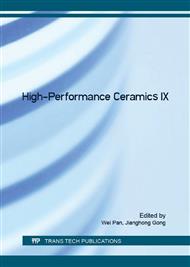[1]
Minh, N.Q., Ceramic fuel cells. Journal of the American Ceramic Society 76 (1993) 563-588.
DOI: 10.1111/j.1151-2916.1993.tb03645.x
Google Scholar
[2]
X. Wu, X. Wu, Q. Liang, J. Fan, D. Weng, Z. Xie, Wei, Shiqiang, Structure and oxygen storage capacity of Pr/Nd doped CeO 2–ZrO 2 mixed oxides. Solid state sciences. 9(2007) 636-643.
DOI: 10.1016/j.solidstatesciences.2007.04.016
Google Scholar
[3]
J. m. Chevalier, L. Gremillard, A. V. Virkar, and D. R. Clarke, The tetragonal monoclinic transformation in zirconia: lessons learned and future trends. Journal of the American Ceramic Society. 92(2009) 1901-(1920).
DOI: 10.1111/j.1551-2916.2009.03278.x
Google Scholar
[4]
A. Suresh, M. J. Mayo, W. D. Porter, and C. J. Rawn, Crystallite and Grain Size Dependent Phase Transformations in Yttria Doped Zirconia. Journal of the American Ceramic Society. 86 (2003) 360-362.
DOI: 10.1111/j.1151-2916.2003.tb00025.x
Google Scholar
[5]
A. Heuer, F. Lange, M. Swain, and A. Evans, Transformation toughening: an overview. Journal of the American Ceramic Society. 69(1986) i-iv.
DOI: 10.1111/j.1151-2916.1986.tb07400.x
Google Scholar
[6]
Piconi, C. and G. Maccauro, Zirconia as a ceramic biomaterial. Biomaterials. 20(1999). 1-25.
DOI: 10.1016/s0142-9612(98)00010-6
Google Scholar
[7]
Kelly, J.R. and I. Denry, Stabilized zirconia as a structural ceramic: an overview. Dental Materials. 24 (2008) 289-298.
DOI: 10.1016/j.dental.2007.05.005
Google Scholar
[8]
Hannink, R.H.J., P.M. Kelly, and B.C. Muddle, Transformation Toughening in Zirconia-Containing Ceramics. Journal of the American Ceramic Society. 83(2000) 461-487.
DOI: 10.1111/j.1151-2916.2000.tb01221.x
Google Scholar
[9]
Zhang, Z., L. Teng, and W. Li, Mechanical properties and microstructures of hot-pressed MgAlON–BN composites. Journal of the European Ceramic Society. 27 (2007) 319-326.
DOI: 10.1016/j.jeurceramsoc.2006.04.184
Google Scholar
[10]
J. Hong, L. Gao, S. Torre, H. Miyamoto, and K. Miyamoto, Spark plasma sintering and mechanical properties of ZrO 2 (Y 2 O 3)–Al 2 O 3 composites. Materials Letters. 43(2000) 27-31.
DOI: 10.1016/s0167-577x(99)00225-6
Google Scholar
[11]
Sun, Y. -h., Y. -f. Zhang, and J. -k. Guo, Microstructure and bending strength of 3Y-TZP ceramics by liquid-phase sintering with CAS addition. Ceramics international. 29 (2003) 229-232.
DOI: 10.1016/s0272-8842(02)00097-4
Google Scholar
[12]
S. Li, H. Izui, M. Okano, W. Zhang, and T. Watanabe, Microstructure and mechanical properties of ZrO2(Y2O3)–Al2O3 nanocomposites prepared by spark plasma sintering. Particuology. 10 (2012) 345-351.
DOI: 10.1016/j.partic.2011.05.002
Google Scholar
[13]
H. -Y. Jin, M. Ishiyama, G. -J. Qiao, J. -Q. Gao, and Z. -H. Jin, Plasma active sintering of silicon carbide. Materials Science and Engineering: A. 483 (2008) 270-273.
DOI: 10.1016/j.msea.2006.09.134
Google Scholar
[14]
Z. Huang, S. Ma, J. Xing, and B. Wang, Bulk Fe2B crystal fabricated by mechanical ball milling and plasma activated sintering. Journal of Alloys and Compounds. 582 (2014) 196-200.
DOI: 10.1016/j.jallcom.2013.07.205
Google Scholar
[15]
Y. Zhang, F. Chen, R. Tu, Q. Shen, and L. Zhang, Field assisted sintering of dense Al-substituted cubic phase Li7La3Zr2O12 solid electrolytes. Journal of Power Sources. 268 (2014) 960-964.
DOI: 10.1016/j.jpowsour.2014.03.148
Google Scholar
[16]
Kern, F. and P. Palmero, Microstructure and mechanical properties of alumina 5vol% zirconia nanocomposites prepared by powder coating and powder mixing routes. Ceramics International. 39(2013) 673-682.
DOI: 10.1016/j.ceramint.2012.06.078
Google Scholar
[17]
Bernard-Granger, G. and C. Guizard, Spark plasma sintering of a commercially available granulated zirconia powder: I. Sintering path and hypotheses about the mechanism (s) controlling densification. Acta Materialia. 55(2007) 3493-3504.
DOI: 10.1016/j.actamat.2007.01.048
Google Scholar
[18]
Mazaheri, M., A. Simchi, and F. Golestani-Fard, Densification and grain growth of nanocrystalline 3Y-TZP during two-step sintering. Journal of the European Ceramic Society. 28(2008) 2933-2939.
DOI: 10.1016/j.jeurceramsoc.2008.04.030
Google Scholar


